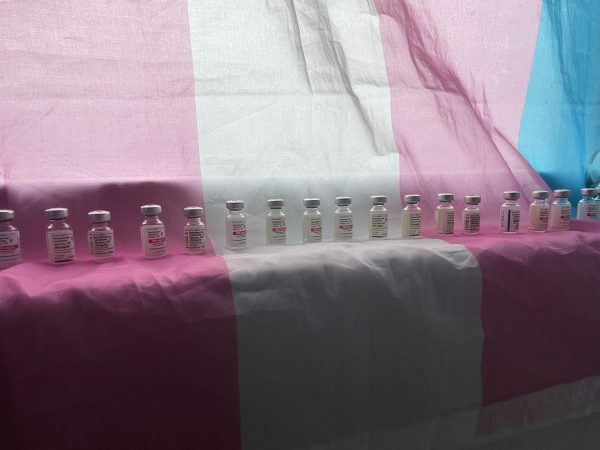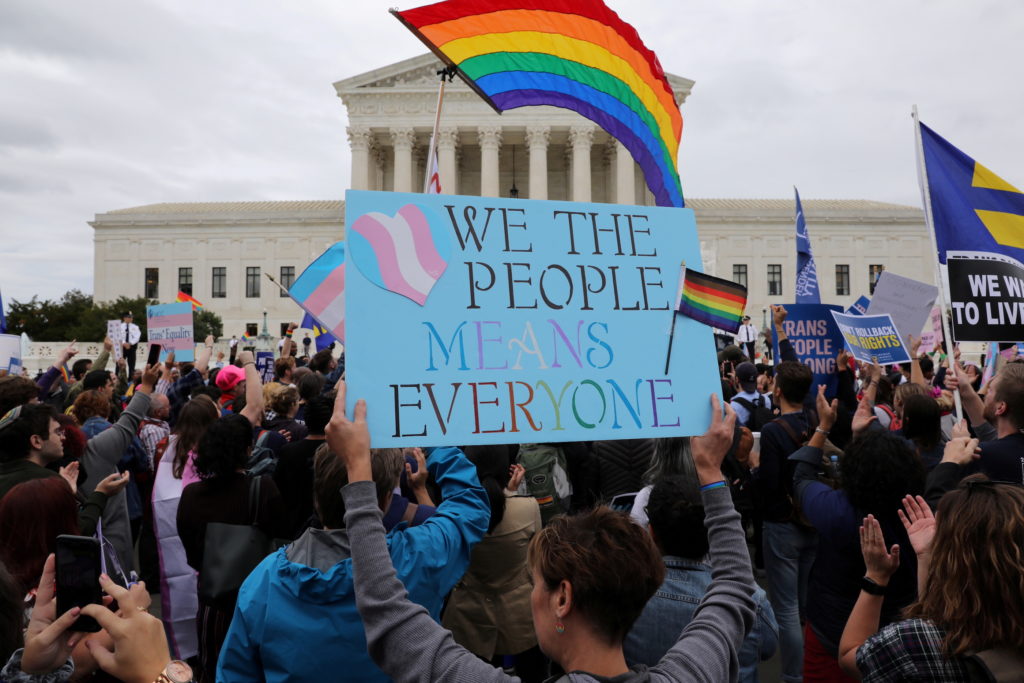You ever have a shirt that doesn’t fit right? Too tight, no matter how much you pull it away from yourself? It clings and it suffocates you, regardless of what you do? And you like this shirt, you want it to fit, you want to feel comfortable in it because it’s a great shirt and it’s yours.
Now imagine that for almost eight years. Day in and day out. And it’s not a shirt, but your very skin, the body you possess. The mirror laughs at you and your skin is far too tight on your body.
Eight years.
I have lived with this body that is not mine for eight years.
I had the chance to make it my own. To make it fit right.
President Trump’s new executive order has ruined that for me and thousands of other transgender adolescents across the nation.
“It’s both a mix of hilarious and absolutely horrifying,” said Charlie, a transgender teen from North Carolina, who declined to give his last name for his own safety. “It’s almost funny to see the sheer stupidity of it, the obnoxious hatred and lack of science; but remembering this is our reality now makes me sick to the stomach.”
Eight days after President Trump’s inauguration, he signed an Executive Order which focused on limiting and in some cases outright banning gender affirming care for minors. These policies come with major backlash from the trans community, human rights groups and many others. It’s not only a matter of bodily autonomy — which has been in question since Roe. V. Wade was overturned — but as well as keeping kids alive, happy and healthy.
On January 28th, President Trump created an executive order titled “Protecting Children from Chemical and Surgical Mutilation.”
“I’m sure kids even younger are [absolutely devastated] too,” said Charlie. “I know myself and my trans friends spent at least 3 weeks after the inauguration living in fear and depression, and, frankly, still feel that way.”
Trump’s Order includes restrictions such as prohibiting the distribution of federal research grants to institutions that offer and continue gender affirming care to minors, it directs the Secretary of the Department of Health and Human Services to end gender affirming care.
Thus, resulting in hospitals and institutions around the country putting a pause or a permanent close on giving this type of care to their patients out of fear of the repercussions.
What does gender affirming care even include?
Gender affirming care includes things such as surgeries, hormone replacement therapy and puberty blockers. To be specific, surgeries are very rarely conducted on minors without informed consent by both parents and the child, it includes, even in the most blue of states, countless hoops to jump through with both insurance and the provider. It is not something given out freely or easily by any means, contrary to what the current administration believes.
Another point of fear that drives this Order is puberty blockers and hormone replacement therapy. Puberty blockers are just as they sound, a medication that simply prevents and puts off puberty and its effects for any individual who may need it — gender non comforting or not, as some cisgender kids may get puberty early might want to put that off until they’re older. Puberty blockers are reversible, if you stop taking them, their effects will stop and puberty will take place, there is no ill effect on the body or permanent damage.
Hormone replacement therapy works the same way, using myself as an example, the effects of testosterone are majorly reversible, and the effects that aren’t, such as voice dropping or other bodily growth, only fully takes effect almost six months after steadily taking hormones. Everything else will naturally revert back to the way it was if you stop taking hormones.
So it turns out the big scary monsters you’re banning, aren’t that scary, nor are they permanent.
You still wanna ban them?
Let’s talk about what gender-affirming care is able to do for our youth; what happens without it?
In a study conducted by Diana Tordoff, Jonathon Wanta and Arin Collin, it was found that 60% found lower odds of moderate to severe depression and 73% had odds of suicidality. And if that’s not enough, take it from a doctor – in a 2021 article by Tori Rodriguez titled “Addressing the Mental Health Needs of Transgender Youth”, Dr. Ralph Vetters was interviewed to talk about the anti-transgender legislation being passed across states.. Dr. Vetters is a pediatrician and medical director at Sidney Borum Jr. Health Center in Boston, which is a program of Fenway Health and a service I frequently use.
“The evidence shows that treatment of trans and gender-variant youth with hormones and puberty blockers decreases suicidality, self-harm, depression, anxiety, substance use, and gender dysphoria,” Vetters said.
Allow me to elaborate on this further. In the same article, it is stated that transgender and non-binary youth are at a higher risk for depression, anxiety and suicidality. There is a 2-3 fold increase in these traits from cisgender and heterosexual youth to gender-nonconforming, with 75% of them experiencing these symptoms. Transgender, non-binary and gender-nonconforming adolescents are also more likely to experience violent victimization than their peers. These numbers would go down if gender affirming care was widespread and available to them, victimization of transgender youth would likely go down if care was provided and allowing them to “pass” as cisgender. (Granted, you do not need to “pass” in any capacity, it is only for the sake of safety or comfort that one might want to “pass”.)
On top of this, trans youth are also more likely to deal with substance abuse and increased risk behaviors.
A group of people that is already struggling is going to be struggling further with these bans, these struggles lead to suicidality, endangering behaviors and higher risks for abuse.
There is no way you can say that gender affirming care is not life saving to those who need it. You can see the results of what happens without it, you can connect the dots of the statistics above with the concept I’m explaining here.
An adolescent is troubled with anxiety/depression already for just being part of the younger generation → They experience gender dysphoria → Gender dysphoria increases these symptoms → Gender dysphoria isn’t able to be relieved by surgery or care → Gender non-conforming youth are at risk of suicide or violent attacks → Kids will die.
Studies conducted by the Trevor Project – a non-profit organization for struggling LGBTQ+ youth – show that LGBTQ+ youth are four times more likely to attempt suicide than cisgender and heterosexual peers, who’s suicide rates are already high, mind you (being the second leading cause of death among youth)
One of the studies conducted by the Trevor Project found that transgender and nonbinary youth who were met with acceptance from their family, friends and peers as well as affirming care had “significantly lower odds” of attempting suicide.

More 1.8 million LGBTQ+ kids consider suicide every year and one attempts every 45 seconds. By the time you’ve finished reading this article, at least a few of my siblings (whether I’ve ever met them or not is irrelevant, we are connected by our struggle), will have attempted and potentially succeeded in ending their lives.
Do you want their blood on your hands?
“This is going to kill kids, there is no doubt in my mind, I hate to even entertain the idea, much less say it, but I’m afraid that’s the goal.”
Have questions? Email me at [email protected].
Struggling?
Trevor Project Hotline: 866-488-7386
Trevor Project Textline: ‘START’ to 678-678
Trans Lifeline: 877-565-8860








